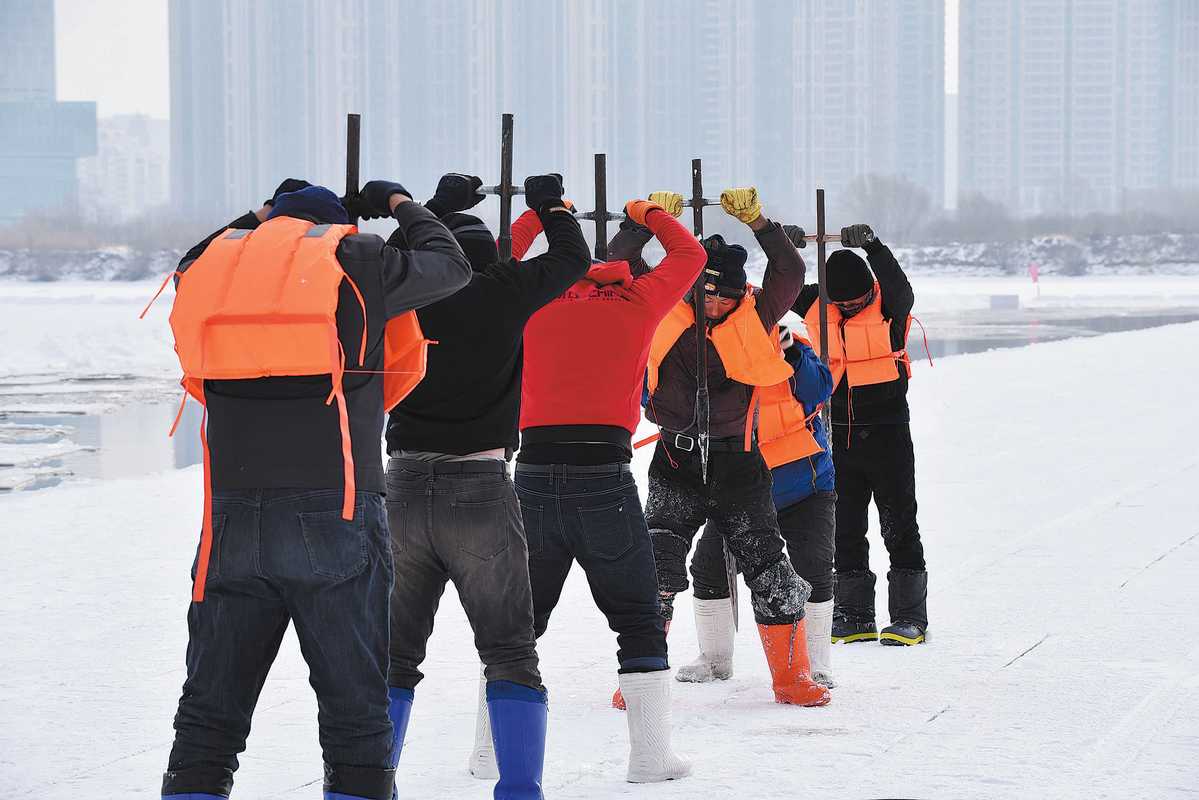
Ice cutters wield steel chisels on the frozen surface of the Songhua River. LIU YANG/FOR CHINA DAILY
In early December, as the ice harvest started in Harbin city, capital of Northeast China's Heilongjiang province, Zhang Jiucheng welcomed his busiest period of the winter.
Over the following weeks, as the night chill would devour the last warmth of the day, Zhang would get up and gingerly leave his home in Wanbao township.
The ice on the Songhua River was waiting for him.
Over the past 26 years, Zhang has spent around 20 days every winter cutting blocks of ice from the frozen river, which are then transported to Harbin where artists carve them into various shapes to transform the city into a glistening wonderland.
In — 20 C temperatures, the sharp river wind blows through Zhang's cotton-padded jacket, and ice-cold water splashes on him, forcing him to take an extra jacket to avoid freezing.
"To protect yourself from cold is of prime importance for this job, otherwise you can neither cut ice anymore, nor make money," Zhang said.
This year, ice-cutting posed a particular challenge to workers like Zhang, because the 26th Harbin Ice and Snow World expanded its scale, requiring more than 300,000 cubic meters of ice.
The intense schedule rushed the thousands of ice cutters onto the river's surface.
"Not everyone can do this, you have to have a strong body, and you have to be quick and skillful," Zhang said. "And, above all, you can never do it all yourself."
Zhang's team has 10 members, and they all work well together, which is "essential for ice-cutting", he said, adding that each block of ice is about 80 centimeters wide, 40 cm thick and 160 cm long, and weighs about 600 kilograms.
First, the team locates the right place near the riverbank, where the ice is the right thickness. Then, they fix an iron rod on the bank and tie a rope to it. The other end is attached to the waist of a worker who stands on the ice and uses a chain saw to cut out a large block.
When the block is about to come loose, they attach it to hooks and then use a towline to lift the slab onto the bank, where it is cut to the required size and taken to the truck for transport.
Every few hours, members of the team take turns doing different tasks.
"There are several rules of thumb. First, don't go to the middle of the river because torrential water under the thin ice can be dangerous," Zhang said.
"Nor can you use the ice within five meters of the bank, because it's always filled with silt," he added.
Moreover, he explained, the worker with the chain saw can never cut along the direction of the current — unless he wants to cause the ice surface to collapse and fall into the water.
"If the worker doesn't cut it right, all the other workers will be in danger. Furthermore, although we tie a rope on the cutter, the freezing water and his heavy clothes are still extremely dangerous if he falls into the river."
Zhang followed that up by noting that he hasn't heard of such an accident occurring for decades.
Due to his rich experience, in recent years, Zhang has also been to some other cities in Heilongjiang, such as Shuangyashan and Jiamusi, to farm ice.
"I have been to so many places to collect ice, but the ice from the Songhua River in our city is the best and the clearest," he said. "I am always proud of it."
Contact the writers at zhouhuiying@chinadaily.com.cn